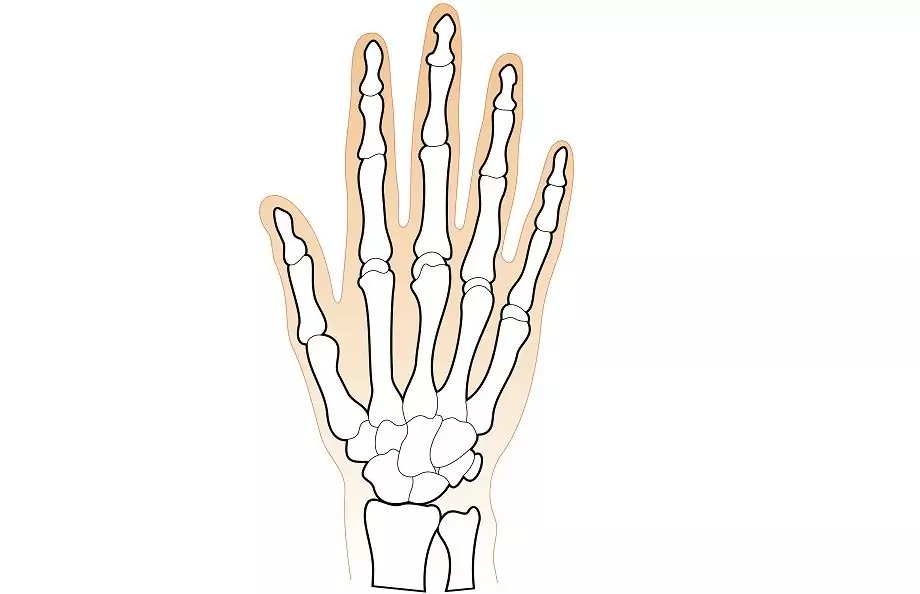- Author Rachel Wainwright [email protected].
- Public 2023-12-15 07:39.
- Last modified 2025-11-02 20:14.
Hygroma brush
The content of the article:
- Causes and risk factors
- Forms of the disease
- Symptoms
- Diagnostics
- Treatment of hygroma brush
- Possible complications and consequences
- Forecast
- Prevention
Hand hygroma is a benign cystic neoplasm that consists of a dense connective tissue wall and viscous contents. Small hand hygromas usually do not cause inconvenience to patients, however, with an increase in the neoplasm or its location next to the nerves, pain occurs, and in some cases the sensitivity of the hand is disturbed.

Source: onkologpro.ru
Hand - the distal part of the upper limb, consisting of three sections: the wrist, the metacarpus and the fingers. The wrist joint has a complex structure and is formed by the lower ends of the ulna, radius, and wrist bones. In the wrist joint, flexion, extension, abduction and adduction of the hand are possible.
About 70% of the total number of hand hygromas are formed on the back of the wrist. Hygromas of the wrist joint of the hand or the palmar surface of the wrist are recorded much less frequently and, as a rule, are located in the projection of the radial artery.
Hygromas make up about 50% of the total structure of benign neoplasms of the wrist joint and are diagnosed about 3 times more often in women than in men. People in their 20s and 30s are most susceptible to pathology; in children and elderly people, this type of neoplasm is rarely found.
Causes and risk factors
The causes of the hygroma of the hand are not fully understood. It is assumed that the main causes of the development of the disease are:
- a genetic predisposition that causes the weakness of the connective tissue structures;
- inflammatory processes in the synovial membrane of the joint capsule or tendon;
- endocrine pathologies;
- surgical interventions;
- single or repeated hand injury;
- constant high stress on the tendon or joint.
At risk of developing hand hygroma are seamstresses, tennis players, pianists, as well as persons whose occupation is related to a computer.
Forms of the disease
Depending on the localization of the pathological process, there are:
- hygromas of the wrist joint of the hand - localized on the back, front or lateral surface of the wrist joint, in the area of the dorsal transverse ligament of the wrist, less often on the palmar surface of the wrist joint;
- hygromas of the back of the fingers - located in the area of the interphalangeal joint or at the base of the distal phalanx;
- hygromas of the palmar side of the fingers - are formed from the tendon sheaths of the flexors of the fingers, can occupy one or two phalanges, less often develop at the base of the fingers;
- hygromas of the distal part of the palm - develop from the tendon sheaths of the flexors of the fingers; have a dense consistency, therefore, they resemble bone or cartilage formations.
Symptoms
Hygroma of the hand can appear suddenly or form over a long time. In about 35% of cases, it has no clinical manifestations. In some patients, especially when the neoplasm is localized under the ligament, the hygroma can go unnoticed for a long time. Such patients usually complain of unpleasant and / or painful sensations during flexion, rotation or grasping movements of the hand.
In the area of the tendon sheath or joint under the skin, a small neoplasm forms, which in most cases is clearly visible. Hygromas of the hand, as a rule, are single, although several hygromas occur simultaneously. The neoplasm can have a soft and elastic (more often) or hard, tumor-like consistency. The base of the hygroma is tightly connected to the underlying tissues, the remaining surfaces are mobile, the skin over the neoplasm is freely displaced, usually not changed. On palpation, the hygroma is usually painless. In some cases, the hygroma of the hand is accompanied by constant dull or radiating pains. Pain in the affected limb can occur after intense physical exertion. In addition, sometimes, after significant physical exertion, the neoplasm increases in size,and at rest it gradually decreases. When the hygroma squeezes the blood vessels, cooling, numbness and pallor of the skin of the hand are observed.
The diameter of the neoplasm, as a rule, does not exceed 3 cm, however, cases of 6-centimeter hygromas are also described. With large cysts, movement in the wrist joint may be limited. Spontaneous resolution of the hygroma of the hand is possible in some cases, provided that the mobility of the joint is limited.
Diagnostics
The diagnosis is made on the basis of the characteristic clinical manifestations of the disease and the history data. An x-ray examination of the hand, ultrasound (allows you to determine the structure of the hygroma, the presence of blood vessels in its walls), computed tomography or magnetic resonance imaging (allows you to determine the structure of the wall of the neoplasm and its contents) may be required. A puncture of the hand hygroma is performed, followed by cytological and histological examination of the material obtained.
Differential diagnosis is carried out with other benign tumors and tumor-like formations (epithelial traumatic cysts, lipomas, atheromas), malignant tumors, and other osteoarticular pathology.
Treatment of hygroma brush
A radical method of treating hand hygroma is its surgical removal. Indications for surgery are pain when moving the hand or at rest, a decrease in the range of motion in the wrist joint, a rapid increase in neoplasm in size, an unaesthetic appearance, or the addition of a secondary infection.

Source: ytimg.com
In some cases, removal of the hygroma of the hand can be carried out on an outpatient basis, however, due to the possibility of opening the joint or tendon sheath, patients are recommended to be hospitalized. Local anesthesia is applied. During the operation, the neoplasm is isolated and excised in such a way that no pathologically altered tissue remains - this reduces the risk of relapse. After excision of the hygroma of the brush, the cavity is washed, sutured, the wound is drained. Then a pressure bandage is applied to the hand, and the limb is fixed with a splint. After 1-2 days from the moment of surgery, the drainage is removed. The stitches are removed on the 7-10th day.
In addition to excision of the hygroma of the hand with an open access scalpel, removal can be carried out endoscopically. The advantages of this method include less tissue trauma and a short rehabilitation period. The laser vaporization method can also be used.
Conservative therapy for hand hygroma is prescribed if there are contraindications to the operation or the patient refuses to carry it out. However, conservative treatment is much less effective, recurrences of hand hygroma in such cases are observed in 80-90% of patients.
One of the conservative methods is hygroma puncture. The method is used for small neoplasms (up to 1 cm in diameter). After puncture and evacuation of the cyst contents, antiseptic and anti-inflammatory drugs are injected into its cavity. The course of treatment may include several punctures carried out at regular intervals. Relapses occur in 70-80% of cases due to the fact that the capsule of the neoplasm is not removed, it remains possible to fill it with synovial fluid.
Removal of the hygroma of the hand by the method of sclerotherapy also consists in carrying out a puncture, however, after the evacuation of the contents, sclerosing preparations are introduced into the cavity, which contribute to the adhesion of its walls, which prevents the re-accumulation of liquid contents. The method of sclerotherapy is more effective than a conventional puncture, but the risk of recurrence in this case remains high.
Physiotherapy can be used both as the main treatment and in addition to the main one. Physiotherapeutic procedures are contraindicated in traumatic damage to the hygroma, as well as in the case of the development of an inflammatory process.
Possible complications and consequences
The main complication of hand hygroma is relapse after treatment, re-growth of the neoplasm is possible even in the case of surgical removal. Also, hygromas can be injured, infected and inflamed.
Forecast
Hygromas do not pose a threat to life. With timely diagnosis and adequate treatment, the prognosis for working capacity is favorable. The hygromas of the hand are not prone to malignant degeneration.
Prevention
In the presence of a genetic predisposition, it is not possible to prevent the development of a hygroma of the hand.
In other cases, it is recommended:
- rationally distribute weight during physical activity on the same group of joints;
- use elastic bandages when doing physical exercise;
- Seek medical attention promptly in case of hand injuries.
YouTube video related to the article:

Anna Aksenova Medical journalist About the author
Education: 2004-2007 "First Kiev Medical College" specialty "Laboratory Diagnostics".
The information is generalized and provided for informational purposes only. At the first sign of illness, see your doctor. Self-medication is hazardous to health!






